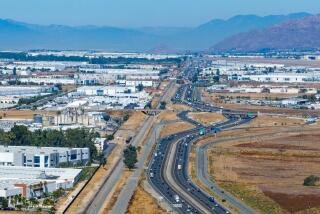Freeway Barnyard : Simi Valley: The Kadota Fig area is home to farm animals despite nearby traffic. But its rural flavor may be in jeopardy.
- Share via
Simi Valley residents who live in the Kadota Fig area are used to waking up to a rooster crowing.
But they also hear cars zooming past their bedroom windows toward the Simi Valley Freeway.
The freeway cuts through the center of the neighborhood, which has long struggled to retain its rural character despite an ever-changing suburban landscape. Some residents still keep chickens, horses, pigs and goats. Others grow vegetable gardens and fruit trees.
Situated in the heart of the city, Kadota Fig is 448 acres bounded by Tapo Canyon Road on the west, Alamo Street on the north, Stearns Street on the east and Cochran Street on the south. Much of the area is zoned for one to two houses per acre, with a provision allowing property owners to keep farm animals.
“It’s kind of an anomaly because the city has grown up around it,” Councilwoman Judy Mikels said.
Mikels and Councilwoman Sandi Webb chair a nine-member committee formed six months ago to determine whether portions of the neighborhood should be rezoned to encourage development.
It is a debate that has divided residents for years and that the city is determined to resolve once and for all.
In July, of 504 property owners who answered a city survey, most preferred to see the area north of the freeway remain as it is.
But landowners south of the freeway were split on the issue of development. Some said they wanted their property zoned for residential development. Others thought that commercial development would be more appropriate.
After the survey, the City Council formed the committee of nine people to help decide the best way to proceed.
“Our position has been that we’re going to do whatever the neighborhood wants,” Mayor Greg Stratton said.
What the residents want depends on which one is asked.
“I would like to see the area stay as rural as possible,” said resident and committee member Kathleen Blackwell, who bought a house on Fig Street three years ago. Blackwell keeps two horses on her one-acre property that includes an arena.
Residents being able to keep not only horses but all types of farm animals is what makes the area unique, she said.
“I specifically moved here for this reason,” she said. “If they take that away, it’ll never be brought back. You’ll lose it forever.”
But Ed Beaudin, a 13-year Cochran Street resident, said the area is no longer suitable for animals. Beaudin said that at one time he raised more than a dozen goats, pigs, chickens and horses on his 2 1/2-acre spread. Now he’s down to three goats, one ceramic dog and 10 plastic ducks.
“It’s no longer good horse property,” he said. “It was nice 10 or 13 years ago, but no longer. . . . It’s out of place. It’s right in the middle of town.”
Beaudin said he would like to see the land zoned for higher density housing, such as apartments or condominiums. He said he also wouldn’t mind seeing portions of it zoned for commercial use.
Whatever happens, Beaudin said he plans to sell his property.
“Some people say, ‘Well, you just bought it to make a profit?’ ” he said. “Well, hell, since when have I ever bought a piece of property not to make a profit? That’s the American way.”
Jim Barlow, a committee member and 16-year resident of Cochran Street, shares the sentiment. Barlow, who used to keep horses on his two-acre property, said he would like to develop it now. He wants the zoning on his street changed to allow residential development on smaller lots.
“Right now I’m allowed to build one house on every 20,000 square feet,” he said. “No one wants to build estate-size houses on estate lots next to the freeway. Simple economics tells me that you have to have smaller lots, with smaller houses.”
Anita Preiss, a horse owner who lives on Barnard Street north of the freeway, said she expects some development along Cochran Street and only hopes that it will be single-family houses and not apartments or condominiums. She hopes that all Kadota Fig residents will keep the right to raise farm animals.
“But I don’t think so,” she said.
Some people on Cochran Street will sell out to the highest bidder, she said. “They don’t care what happens. All they care about is the almighty dollar.”
Meanwhile, Mikels said the Kadota Fig area is no longer an appropriate setting for livestock.
“If you can divorce yourself from the emotional part of it and look at it logically, it makes absolutely no sense,” she said. “This is a neighborhood divided by a freeway and bordered on all sides by major arterials.”
Mikels said most horse owners live in the outlying areas of the city where there are riding trails.
“We probably should look at it in terms of a redevelopment area,” she said of Kadota Fig. “But the people who live there don’t want that to happen.”
Webb said changes in the area south of the freeway are likely.
“There is no question that some development is going to take place; it’s just a matter of what kind of development,” she said.
As for allowing animals, city officials said they will abide by the wishes of the residents.
“If people want to keep animals, then I believe they have every right to keep them,” Stratton said.
Mikels said the committee, which has held regular meetings and public hearings since it was formed, is expected to make recommendations to the council in early June.
“Hopefully, we can come up with a balance between the emotional and the practical,” she said.
More to Read
Sign up for Essential California
The most important California stories and recommendations in your inbox every morning.
You may occasionally receive promotional content from the Los Angeles Times.













